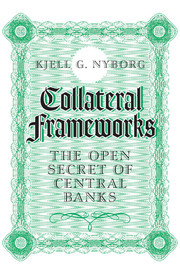Book contents
- Frontmatter
- Contents
- List of Figures
- List of Tables
- List of Exhibits
- List of Examples
- Preface
- Acknowledgments
- 1 Background and Motivation
- 2 Collateral Frameworks: Overview
- 3 Monetary Policy Implementation in the Euro Area over Time
- 4 Evidence on the Production and Usage of Collateral
- 5 Haircuts
- 6 Ratings and Guarantees
- 7 Market and Theoretical Prices
- 8 Collateral “Own Use”
- 9 Non-regulated Markets, Unsecured Bank Debt, and LTRO Uptake
- 10 Market Discipline
- 11 Bailing Out the Euro
- 12 The Endgame of the Euro Crisis
- 13 Restoring Credibility
- 14 The Problem with Collateral
- 15 Concluding Remarks
- Appendix: Haircut and Rating Rules Updates
- References
- Index
7 - Market and Theoretical Prices
Published online by Cambridge University Press: 06 January 2017
- Frontmatter
- Contents
- List of Figures
- List of Tables
- List of Exhibits
- List of Examples
- Preface
- Acknowledgments
- 1 Background and Motivation
- 2 Collateral Frameworks: Overview
- 3 Monetary Policy Implementation in the Euro Area over Time
- 4 Evidence on the Production and Usage of Collateral
- 5 Haircuts
- 6 Ratings and Guarantees
- 7 Market and Theoretical Prices
- 8 Collateral “Own Use”
- 9 Non-regulated Markets, Unsecured Bank Debt, and LTRO Uptake
- 10 Market Discipline
- 11 Bailing Out the Euro
- 12 The Endgame of the Euro Crisis
- 13 Restoring Credibility
- 14 The Problem with Collateral
- 15 Concluding Remarks
- Appendix: Haircut and Rating Rules Updates
- References
- Index
Summary
As shown in Equation (2.1), the collateral value of a security in Eurosystem operations is its market, or in some cases, model, price less its haircut. The rules that determine whether a market or theoretical (model) price is used are laid down in the official documentation of the Eurosystem's collateral framework. As one would expect, there are separate pricing rules for marketable and nonmarketable collateral. This chapter describes changes to these rules over time, with a focus on marketable collateral. Non-marketable collateral is discussed toward the end. The chapter also provides evidence on the incidence of theoretical prices, initially in terms of the public list of eligible marketable collateral. This is followed by an estimate of the incidence of theoretical prices among pledged collateral.
ELIGIBLE MARKETABLE COLLATERAL
From January 1, 2007, to January 2, 2013, the pricing rule for marketable collateral was:
Pricing rule 1
The value of a marketable asset is calculated on the basis of the most representative price on the business day preceding the valuation date. If more than one price is quoted, the lowest of these prices (normally the bid price) is used. In the absence of a representative price for a particular asset on the business day preceding the valuation date, the last trading price is used. If the reference price obtained is older than five days, or has not moved for at least five days, the Eurosystem defines a theoretical price.
ECB (2006/12)This passage reveals that both stale and theoretical prices are built into the collateral framework. Theoretical prices are used if market prices do not exist or are too stale, that is, more than five days old over the 2007–2012 time period. The pricing rule before 2007 was similar, but without the five-day staleness limit (ECB 2000/7 and 2005/2). The combination of haircuts that are rarely revised (Chapter 5) and stale or theoretical prices has the potential to create biases, along the lines of those documented in Chapter 4.
- Type
- Chapter
- Information
- Collateral FrameworksThe Open Secret of Central Banks, pp. 149 - 167Publisher: Cambridge University PressPrint publication year: 2016



